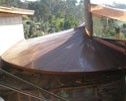Roofing workers may be exposed to a number of significant hazards, including falls, burns, cuts, and exposures to chemicals or other hazardous substances. One area of concern that may require safety and health professionals' attention, particularly during summer months, is illness related to exposures to the sun and heat.
Keep in mind: Symptoms related to heat illness often are subtle, and dangers from exposure quickly can progress from minor to life-threatening.
Manifestations
There are three commonly recognized manifestations of heat illness: heat cramps, heat exhaustion and heat stroke.
Heat cramps, the mildest form of heat illness, are muscle spasms or cramps that most commonly occur in the legs. Heat cramps usually result from intense physical work in the sun or hot work areas and often are exacerbated by lack of water intake. A worker suffering from heat cramps must rest and drink water, juice or sports drinks; massaging affected muscles also may provide relief.
Heat exhaustion also may result from strenuous work in the sun or a hot environment. A worker suffering from heat exhaustion ordinarily sweats profusely; has an increased heartbeat; and may experience heat cramps, nausea or dizziness. If a worker experiencing such symptoms is not moved to a cool, shaded area and given water, these symptoms can progress to heat stroke.
Heat stroke is the most dangerous heat-related illness and has the potential to be life-threatening. It also can result from strenuous work in the sun on hot days or in a hot environment especially if water intake is insufficient. A worker suffering from heat stroke typically has a high body temperature of more than 100 F and may show signs of confusion or disorientation. The worker may experience a rapid heartbeat, headache, and shortness of breath or increased respirations. As heat stroke progresses, the worker may faint, lose consciousness or even lapse into a coma.
A worker suffering from heat stroke should be moved to a shaded area and given water or other liquids that do not contain alcohol or caffeine. You also should call 911 immediately.
Regulations
The Occupational Safety and Health Administration (OSHA) does not specifically regulate how employers analyze heat illness hazards or develop controls for those hazards. However, according to OSHA's general duty clause, employers must provide workplaces free from recognized hazards likely to cause death or serious injury. Under that provision, a roofing contractor may be subject to an OSHA citation if a recognized heat illness hazard is not avoided or controlled.
California's Division of Occupational Safety and Health, or Cal/OSHA, which administers the state's worker safety regulations, has had a specific regulation addressing heat illness in effect for almost five years. Its provisions may be useful for roofing contractors throughout the U.S. in determining controls to put in place for heat-related illness.
The regulation states 1 quart of water per employee per hour must be available throughout the workday—a total of 2 gallons of water per employee during a typical workday.
In addition, Cal/OSHA requires employers to provide a shaded area for workers to access as needed during the workday. The shaded area must be open to the air, ventilated or cooled. Workers can use the shaded area for a minimum of five minutes to relieve heat illness or prevent its onset according to the regulation.
Assess risks
Heat illness can be a health issue in any U.S. region, and you should assess heat-related risks to your employees and determine appropriate control measures.
More information about analyzing hazards stemming from work in hot, sunny weather and training workers about heat-related illness is available from Cal/OSHA at www.dir.ca.gov and the National Safety Council at www.nsc.org.
Harry Dietz is NRCA's director of risk management.



